The AMD Ryzen 7 5800X3D Review: 96 MB of L3 3D V-Cache Designed For Gamers
by Gavin Bonshor on June 30, 2022 8:00 AM EST- Posted in
- CPUs
- AMD
- DDR4
- AM4
- Ryzen
- V-Cache
- Ryzen 7 5800X3D
- Zen3
- 3D V-Cache
Final Words
For users in the market for a new CPU designed to bolster frame rates in a gaming system, the AMD Ryzen 5800X3D is undoubtedly a powerful choice.
Even at $449, the Ryzen 7 5800X3D can perform as well, if not at times better than any chip from Intel's 12th Gen Core series of processors. The catch is that, as is often the case with new/unique technologies, the gains are uneven among games. This essentially means if the game doesn't benefit from the large 96 MB of 3D V-Cache onboard, it performs similar to the already existing Ryzen 7 5800X, which can be had for $350; $100 cheaper than the 5800X3D. In that respect, it would be helpful if AMD published a guide of games that they've found to materially benefit from the large L3 cache, just so gamers and users could decide whether the Ryzen 7 5800X3D is worth it.
The other angle is that, compared to the Intel ecosystem, the Intel Core i7-12700K for $380 represents a better buy in terms of all-around performance, where it has the advantage in most CPU compute workloads. So while the Ryzen 7 5800X3D has a niche it does quite well at, there's certainly an opportunity cost in getting this chip versus something that is a bit more rounded.
Let's dissect the performance across the different areas such as gaming and compute:
AMD Ryzen 7 5800X3D Analysis: Biased Towards Gamers
Looking at our data across our CPU testing suites (compute and gaming), the AMD Ryzen 7 5800X3D is a mixed bag. The Ryzen 7 5800X3D has an MSRP of $449 and represents a $100 hike over what the original Ryzen 7 5800X ($350) is currently selling for. Now let's dissect our analysis into two sections, gaming and compute, and piece it together.
AMD Ryzen 7 5800X3D Gaming Analysis: 3D V-Cache is Fantastic For Some Games (But Not All)
When AMD initially announced its Ryzen 7 5800X3D processor with its latest technological advancement in 3D V-Cache stacking, AMD made it clear that this processor was explicitly designed for gamers. The idea was that the additional levels of L3 Cache would play more to gamer's strengths with a larger buffer for more frequently used data instead of directly accessing it from system memory (DRAM). In gaming, a larger pool of L3 cache can indeed benefit and improve frametimes, as this data is closer to the CPU cores and is more quickly accessed by the individual cores from the processor as it would when accessing it from DRAM.
Now it's worth mentioning that in our testing, AMD's V-Cache-equipped chip didn't annihilate the competition in all of the games in our suite. Still, it certainly significantly impacted AMD-favored titles in its arsenal.
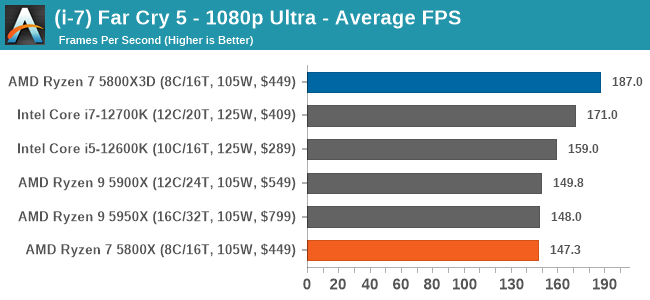
Looking at performance in Far Cry 5 at 1080p Ultra, which is notably an AMD partnered title, the AMD Ryzen 7 5800X3D with 96 MB of 3D stacked L3 Cache performed just under 27% faster than the previous AMD Ryzen 7 5800X processor. It was also around 9% better than the similarly priced Intel Core i7-12700K, which benefits from four more cores, higher IPC performance, and faster cores than the 5800X3D.
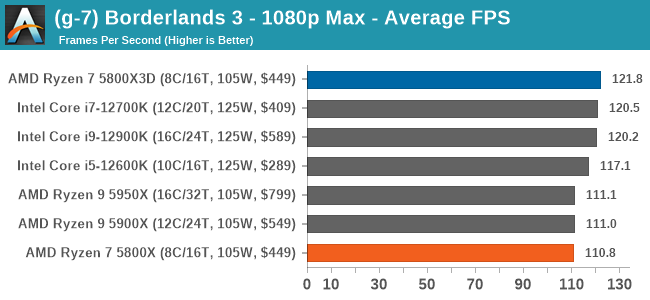
In Borderlands 3 at 1080p with maximum settings, the AMD Ryzen 7 5800X3D also topped our tables, even beating out the more expensive and premium Intel Core i9-12900K by over 1%, and beats all of the other Ryzen 5000 processors tested. This does give AMD some affirmation that its 3D V-Cache can push its technology as a win for gamers. Still, unfortunately, not every game title will benefit from massive levels of L3 Cache.
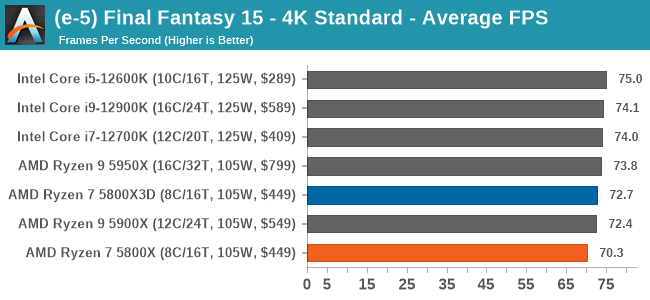
As for 4K gaming, there's not a lot to say here. This is almost always the realm of GPU-limited games, which limits the benefits a faster CPU can bring. Focusing on Final Fantasy 15 at 4K resolutions and using the standard preset, the 96 MB of L3 didn't have the desired effect on performance. The Ryzen 7 5700X3D does pull ahead, beating the previous Ryzen 7 5800X by around 3.4%, but it's small potatoes at this point.
AMD Ryzen 7 5800X3D Compute Analysis: Extra L3 Does Little For Compute Performance
While AMD pitched the Ryzen 7 5800X3D and its 96 MB of L3 cache as being beneficial in gaming, they didn't make the same kind of claims when it comes to applications and general compute performance. Because the benefits of a larger L3 cache are even more sporadic in these cases, AMD has wisely opted not to promote the part based on general compute performance here. Which is not to say that it's bad news for AMD, but as our data confirms, the L3 cache generally doesn't have much of an impact here.
It's worth noting that due to the 3D V-Cache, which is essentially 32 MB + 64 MB stacked vertically on top of each other using AMD's new chiplet packaging technology, AMD has had to be more conservative with core frequency to be in line with its 105 W TDP power rating. In comparison to the Ryzen 7 5800X, which has a base frequency of 3.8 GHz and a turbo core clock speed of 4.7 GHz, the Ryzen 7 5800X3D has a 400 MHz lower base frequency of 3.4 GHz, which its turbo core frequency is 200 MHz lower by comparison with a maximum core frequency of 4.5 GHz. This reduction in core frequency plays a key role in compute performance when directly comparing the 5800X3D and 5800X.
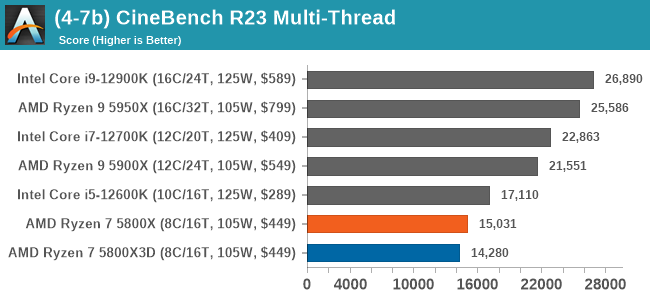
Looking at multi-threaded performance in Cinebench R23, the Ryzen 7 5800X3D performs 5.2% worse off than the existing Ryzen 7 5800X. This can be directly attributed to the differences in core frequency.
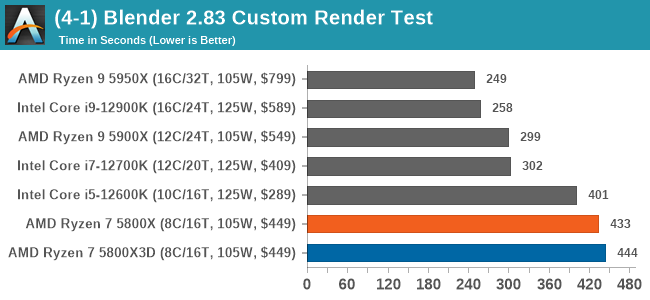
In our Blender 2.83 benchmark, the additional 64 MB of L3 cache on the Ryzen 7 5800X3D over the Ryzen 7 5800X made no difference in performance. Once again, the extra 3D stacked L3 V-Cache made no real impression on compute performance. With the critical sections of many non-gaming workloads either fitting within the confines of current L3 caches – or not fitting at all – there's no making up for more cores and higher clockspeeds most of the time.
AMD Ryzen 7 5800X3D is For Gaming, But Compute Performance is Average
Touted as the 'World's Fastest PC Gaming Processor' by AMD, this claim rings true in some aspects but not so much in others. The keyword in this claim is gaming, and it's true that the additional 64 MB of L3 cache does bring many benefits to the gaming market, albeit benefiting some games more than others.
The general outcome of our analysis is straightforward. If a specific title can benefit from a larger L3 cache, then the Ryzen 7 5800X3D and its 3D stacked V-Cache will prove very potent and fruitful to gamers looking to maximize frame rates. In situations where the game cannot benefit from the extra L3 cache, then the Intel 12th Gen Core series chips prove better with higher core clock speeds and higher IPC leading to higher overall performance.
The biggest benefits to gaming performance came in 720p and lower resolutions – which is to be expected since the CPU-limited scenario is something of a best case here – but the Ryzen 7 5800X3D at 1080p and 4K proved fruitful in selected titles. So even in workloads where the CPU isn't entirely free to run ahead of the GPU, it's clear that there's still some benefit to AMD's latest chip.
Otherwise, when it comes to raw compute performance, the Ryzen 7 5800X3D isn't as potent as Intel's 12th Gen Core processors – and in most of our computational-related tests, it also fell behind the vanilla Ryzen 7 5800X processor. This is because the L3 cache doesn't have as much of an influence on general purpose compute performance, and the Ryzen 7 5800X3D is clocked slightly lower due to voltage restraints (1.35 V) on the VCore.
Ultimately, It's pretty easy to make a case for the Ryzen 7 5800X3D as a solid gaming chip, especially as it decimates the competition in some titles. Just so long as potential buyers understand that the Ryzen 7 5800X3D is going to excel in gaming more than it excels in Excel. Otherwise, for users looking for a solid all-rounder capable of reasonable frame rates in gaming and reliable application and productivity performance, the Intel Core 12th Gen series has a little more oomph under the hood, albeit with a much higher power draw.
Performance matters aside, the Ryzen 7 5800X3D and its other V-cache ilk represent a massive step forward for AMD's engineering team. Stacking additional L3 cache is a novel way to expand the size of the L3 pool without significantly blowing up die sizes or resort to high-latency off-die caches, which gives AMD some important flexibility here to make such a part viable.
And clearly, AMD is happy with what they've accomplished as well. Along with the Ryzen chip, AMD has rolled out V-cache chips for enterprise and server products, where it is already playing a critical factor in performance. As a result, it comes as no surprise that AMD has confirmed that there will be 3D V-Cache products on its impending Zen 4 core (due fall 2022), and with Zen 5 which is expected sometime in 2024, with both consumer (Ryzen) and server (EPYC) products planned. So while all signs point to V-cache remaining a premium solution, it also means that we're far from done seeing what AMD can do for PC performance with larger L3 caches.


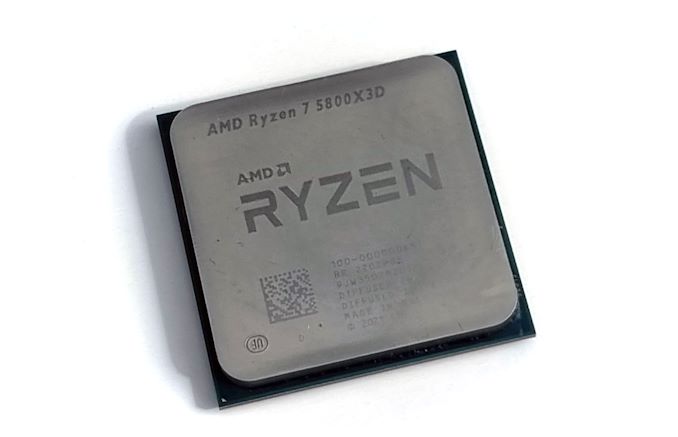








125 Comments
View All Comments
iphonebestgamephone - Thursday, June 30, 2022 - link
They probably found it not as important as this one.Kangal - Friday, July 1, 2022 - link
There's no Andrei... so maybe you're right.iphonebestgamephone - Friday, July 1, 2022 - link
Andrei be busy with the nuvia cores.Silver5urfer - Thursday, June 30, 2022 - link
Forget this chip because at this point anyone is better off with a 5900X as it's far superior in MT plus higher cores. This thing is locked for tuning, and the X3D is causing the clock speed deficit on top. The only advantage is low voltage for PBO as it runs at 1.3v only vs the usual Zen 3 at 1.4v.The major issue is AMD BIOS and Firmware. It's not upto the mark the 1.2.0.7 is finally out it fixes a lot of things BUT the core problems of USB are not fixed. Anyone who has Ryzen 2000 should get a 5900X once Ryzen 7000 launches, not only you can get more cores at cheap plus also a beast at MT which can be used at any task. Not some gaming only junk. This thing struggles on RPCS3 emulation too. You need ST performance and high clocks for such and major workloads the L3 cache is great but the limitations are not worth spending over $450 for this, you can get a 10850K for $320 if you looked for deals, that's a 10C20T CPU which will destroy this processor in all workloads and if you add OC it will be as fast as a 12th gen, check Tomshardware CPU ranking list for gaming here and see for yourself how 10th gen fares better you don't have to deal with BS BIOS issues, USB problems etc
https://www.tomshardware.com/reviews/cpu-hierarchy...
For those who want to buy new, wait for AMD Ryzen 7000 or Z790, Z690 has ILM problems you must avoid it. Ryzen is buggy platform. You are left with Intel 10th gen, it's best but the PCIe3.0 is it's downside.
nandnandnand - Thursday, June 30, 2022 - link
The fact that it can trade blows with the 12900K/S often in gaming makes the 5800X3D impossible to so easily dismiss for current AM4 owners. You could get a cheaper 5900X, but if you don't need the extra cores, you won't notice the difference.It would be better to get it on sale for far less than $450, but the supply might be kept low to make that difficult. AMD gets more $$$ from sending these cache chiplets to Epyc Milan-X customers.
Going forward, I think AMD should offer the 16-core 7950X only with V-Cache, delaying it after the other models, and 7800X with and without V-Cache.
Khanan - Thursday, June 30, 2022 - link
That won’t happen as again 7950X is a mixed cpu not entirely for gamers. So the likeliness is high only the 8 core will get 3DVCache again.nandnandnand - Thursday, June 30, 2022 - link
I don't think they will launch it on only the 8-core 2 generations in a row. 5800X3D is an experiment, soon it's time to make it normal. 7950X is the obvious choice since it uses good chiplets and it's a low-volume halo product.It would also be nice to see a 6-core with a bad yield partial cache chip on top, but that's probably a pipe dream.
Khanan - Friday, July 1, 2022 - link
3DVC mostly scales for gaming so again it makes no sense to give it a production CPU. And lol no 7950X is no low volume product, if sells in the millions. It’s a content creation CPU, also who said 5800X3D is a experiment? Lol so many nonsensical comments hereSilver5urfer - Friday, July 1, 2022 - link
5800X3D is an experimental SKU, the fact that it cannot handle tuning is first, second it's not high saturation since Zen 3 is already at peak which means it's low volume. Third, this is a reject EPYC chiplet which is why AMD segregated it to a single SKU vs whole Stack of X3D refresh on Zen 3. Plus this thing is just AMD looking at how things work IRL when they use their 3D Cache for Consumer processors to understand how the CPU makes market react.It is not going to get any new consumers for AMD, AM4 is a dead end socket. Using this SKU priced at $450 to buy is worse and I certainly would not given the QC of AMD in Firmware.
Anything I disagree = nonsense I guess lol.
Kangal - Friday, July 1, 2022 - link
It would make more sense if AMD did one more "experimental" release with V/3D-Cache on their 8-core Zen4 processor (r7-7800X3D). But then I think they should offer it throughout the product stack, utilising the "X" moniker, and making their Planar/2D-Cache on their regular options:- r9-8950 vs 8950X
- r9-8900 vs 8900X
- r7-8800 vs 8800X
- r5-8600 vs 8600X